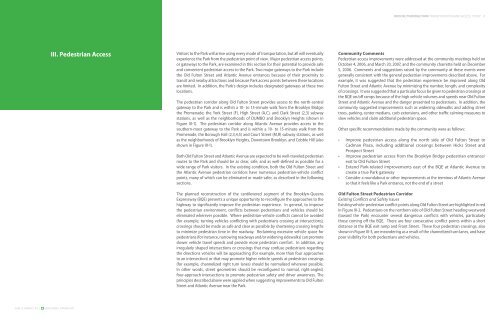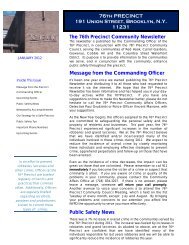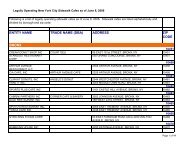Brooklyn Bridge Park Transportation Study, 3/2008
Brooklyn Bridge Park Transportation Study, 3/2008
Brooklyn Bridge Park Transportation Study, 3/2008
Create successful ePaper yourself
Turn your PDF publications into a flip-book with our unique Google optimized e-Paper software.
SAm SChwARTz PLLC hDR-DANIEL FRANkFURT<br />
III. Pedestrian Access<br />
Visitors to the <strong>Park</strong> will arrive using every mode of transportation, but all will eventually<br />
experience the <strong>Park</strong> from the pedestrian point of view. Major pedestrian access points,<br />
or gateways to the <strong>Park</strong>, are examined in this section for their potential to provide safe<br />
and convenient pedestrian access to the <strong>Park</strong>. Two major gateways to the <strong>Park</strong> include<br />
the Old Fulton Street and Atlantic Avenue entrances because of their proximity to<br />
transit and nearby attractions and because <strong>Park</strong> access points between these locations<br />
are limited. In addition, the <strong>Park</strong>’s design includes designated gateways at these two<br />
locations.<br />
The pedestrian corridor along Old Fulton Street provides access to the north-central<br />
gateway to the <strong>Park</strong> and is within a 10- to 15-minute walk from the <strong>Brooklyn</strong> <strong>Bridge</strong>;<br />
the Promenade; the York Street (F), High Street (A,C), and Clark Street (2,3) subway<br />
stations, as well as the neighborhoods of DUMBO and <strong>Brooklyn</strong> Heights (shown in<br />
Figure III-1). The pedestrian corridor along Atlantic Avenue provides access to the<br />
southern-most gateway to the <strong>Park</strong> and is within a 10- to 15-minute walk from the<br />
Promenade, the Borough Hall (2,3,4,5) and Court Street (M,R) subway stations, as well<br />
as the neighborhoods of <strong>Brooklyn</strong> Heights, Downtown <strong>Brooklyn</strong>, and Cobble Hill (also<br />
shown in Figure III-1).<br />
Both Old Fulton Street and Atlantic Avenue are expected to be well-traveled pedestrian<br />
routes to the <strong>Park</strong> and should be as clear, safe, and as well-defined as possible for a<br />
wide range of <strong>Park</strong> visitors. In the existing condition, both the Old Fulton Street and<br />
the Atlantic Avenue pedestrian corridors have numerous pedestrian-vehicle conflict<br />
points, many of which can be eliminated or made safer, as described in the following<br />
sections.<br />
The planned reconstruction of the cantilevered segment of the <strong>Brooklyn</strong>-Queens<br />
Expressway (BQE) presents a unique opportunity to reconfigure the approaches to the<br />
highway to significantly improve the pedestrian experience. In general, to improve<br />
the pedestrian environment, conflicts between pedestrians and vehicles should be<br />
eliminated wherever possible. Where pedestrian-vehicle conflicts cannot be avoided<br />
(for example, turning vehicles conflicting with pedestrians crossing at intersections),<br />
crossings should be made as safe and clear as possible by shortening crossing lengths<br />
to minimize pedestrian time in the roadway. Reclaiming excessive vehicle space for<br />
pedestrians (for instance, narrowing roadways and/or widening sidewalks) can promote<br />
slower vehicle travel speeds and provide more pedestrian comfort. In addition, any<br />
irregularly shaped intersections or crossings that may confuse pedestrians regarding<br />
the directions vehicles will be approaching (for example, more than four approaches<br />
to an intersection) or that may promote higher vehicle speeds at pedestrian crossings<br />
(for example, channelized right turn lanes) should be normalized wherever possible.<br />
In other words, street geometries should be reconfigured to normal, right-angled,<br />
four-approach intersections to promote pedestrian safety and driver awareness. The<br />
principles described above were applied when suggesting improvements to Old Fulton<br />
Street and Atlantic Avenue near the <strong>Park</strong>.<br />
BROOKLYN BRIDGE PARK TRANSPORTATION AND ACCESS STUDY 1<br />
Community Comments<br />
Pedestrian access improvements were addressed at the community meetings held on<br />
October 4, 2006, and March 20, 2007, and the community charrette held on December<br />
5, 2006. Comments and suggestions raised by the community at these events were<br />
generally consistent with the general pedestrian improvements described above. For<br />
example, it was suggested that the pedestrian experience be improved along Old<br />
Fulton Street and Atlantic Avenue by minimizing the number, length, and complexity<br />
of crossings. It was suggested that a particular focus be given to pedestrian crossings at<br />
the BQE on/off ramps because of the high vehicle volumes and speeds near Old Fulton<br />
Street and Atlantic Avenue and the danger presented to pedestrians. In addition, the<br />
community suggested improvements such as widening sidewalks and adding street<br />
trees, parking, center medians, curb extensions, and other traffic calming measures to<br />
slow vehicles and claim additional pedestrian space.<br />
Other specific recommendations made by the community were as follows:<br />
•<br />
•<br />
•<br />
•<br />
Improve pedestrian access along the north side of Old Fulton Street to<br />
Cadman Plaza, including additional crossings between Hicks Street and<br />
Prospect Street<br />
Improve pedestrian access from the <strong>Brooklyn</strong> <strong>Bridge</strong> pedestrian entrance/<br />
exit to Old Fulton Street<br />
Extend <strong>Park</strong>-related improvements east of the BQE at Atlantic Avenue to<br />
create a true <strong>Park</strong> gateway<br />
Consider a roundabout or other improvements at the terminus of Atlantic Avenue<br />
so that it feels like a <strong>Park</strong> entrance, not the end of a street<br />
Old Fulton Street Pedestrian Corridor<br />
Existing Conflicts and Safety Issues<br />
Existing vehicle-pedestrian conflict points along Old Fulton Street are highlighted in red<br />
in Figure III-2. Pedestrians on the northern side of Old Fulton Street heading westward<br />
(toward the <strong>Park</strong>) encounter several dangerous conflicts with vehicles, particularly<br />
those coming off the BQE. There are four consecutive conflict points within a short<br />
distance at the BQE exit ramp and Front Street. These four pedestrian crossings, also<br />
shown in Figure III-3, are meandering as a result of the channelized turn lanes, and have<br />
poor visibility for both pedestrians and vehicles.




